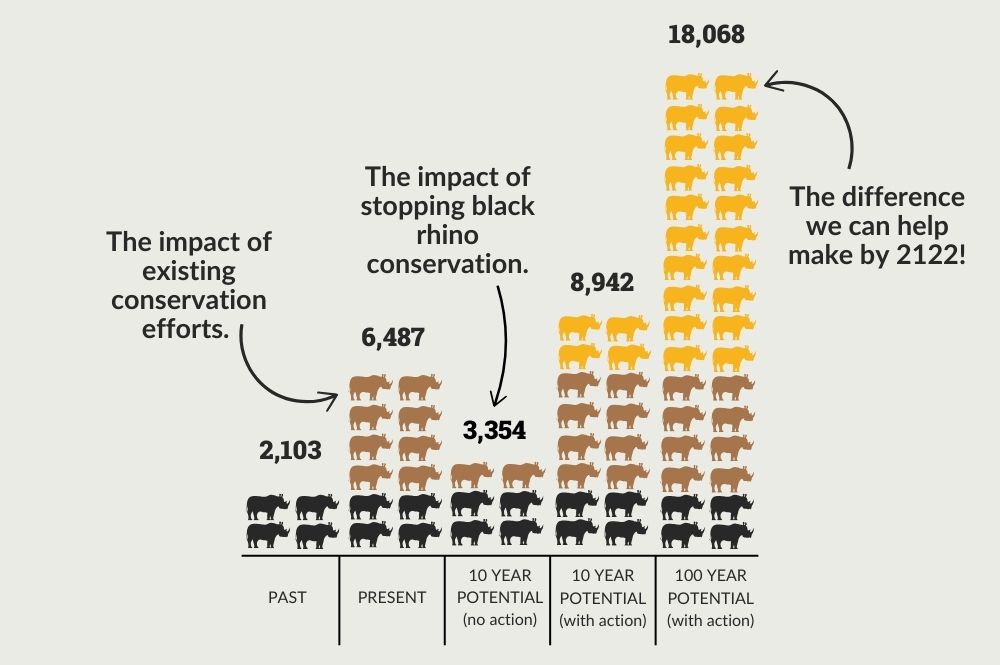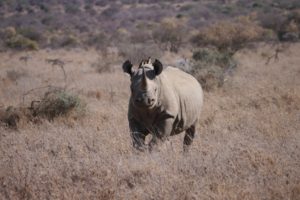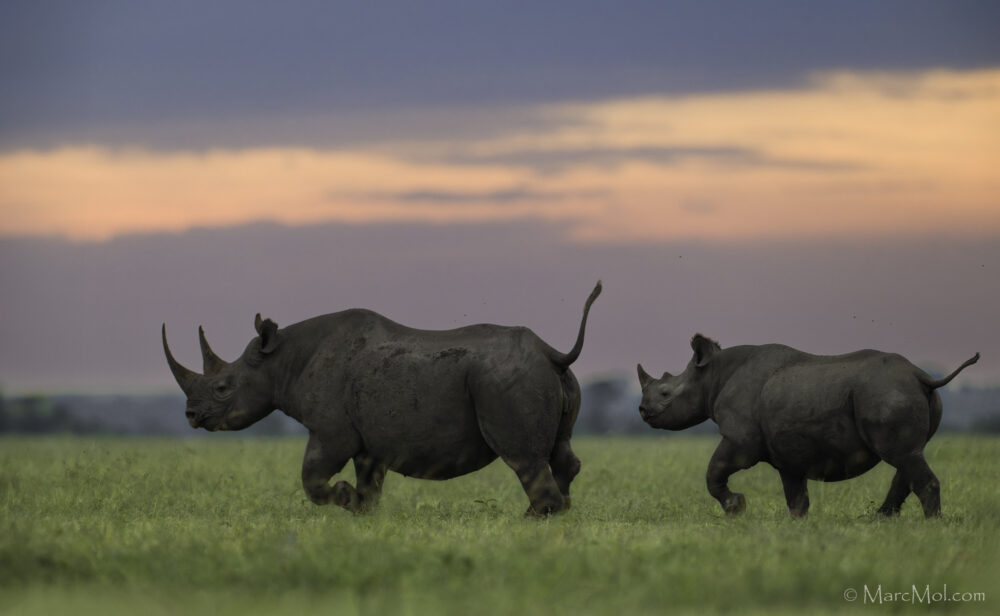The dramatic drop in black rhino numbers – from an estimated 100,000 animals around the 1900s to fewer than 2,400 in the mid-1990s – is, sadly, well-recognised as one of the steepest declines of a large mammal species. However, the impressive recovery of the species since this low is less well-known.
A brief history of black rhino numbers
With four subspecies and a habitat range across much of southern, eastern and central Africa, black rhinos were once abundant across the continent. Towards the end of the 20th century, poaching, coupled with intense habitat loss, drove the species’ rapid decline. The lowest numbers for each subspecies occurred at different times:
- 1984: 418 South-western black rhinos
- 1994: 1,202 South-central black rhinos
- 1997: 483 Eastern black rhinos
- 2006: Western black rhinos declared extinct
Fast-forward to today, and while the species remains at extremely high risk of extinction in the wild (black rhinos are listed as Critically Endangered by the International Union for the Conservation of Nature (IUCN)), numbers have grown substantially.
Dedicated conservation efforts ensured that by the end of 2023, there were 6,421 black rhinos across Africa. This success was achieved through innovative biological management, including re-introducing rhinos into their previous ranges, maintaining annual growth rates exceeding 5%, and meticulously managing rhinos across meta-populations. In parallel, the safety of rhino habitats was secured through dedicated protection efforts at individual sites, alongside addressing transnational organised criminal networks.
The IUCN Green List tool
The IUCN Green List is a sustainability standard that provides a global benchmark for meeting the environmental challenges of the 21st century. The Green List tool can help us understand the impact of different strategic activities, measuring how they benefit the conservation of individual species.
A recent analysis produced by scientists from the IUCN Species Survival Commission (SSC) African Rhino Specialist Group (AfRSG) used the tool to assess black rhino recovery.
The tool has four measures:
1. Conservation Legacy, which reflects the impact of past conservation interventions;
The analysis showed that without conservation actions, fewer than 300 black rhinos (somewhere between 281 and 312) would exist in Africa today. However, the actual count of 6,191 black rhinos in 2022 – meaning a conservation legacy of more than 5,800 animals thanks to conservation efforts!
2. Conservation Dependence, which predicts what might happen during the next 10 years if all current conservation actions were stopped;
If all conservation efforts were to cease for the next 10 years, the analysis showed that only around 3,300 (somewhere between 3,267 and 3,444) black rhinos might be alive in Africa by 2032. This means that the future of more than 3,100 rhinos depends on conservation actions.
3. Conservation Gain, which estimates the change expected to occur if conservation actions continue for the next 10 years;
The decadal forecasts predicted that if we maintain current efforts, there could be more than 8,900 (8,702 – 9,193) black rhinos living in Africa in 2032, calculated as a conservation gain of 2,456.
4. Recovery Potential, which reflects what may be achievable in 100 years, considering trends in global environmental change drivers;
The recovery potential for black rhinos in 2122 could be nearly 21,000 (20,620 – 21,267) animals, based on long-term predictions of available habitat. This prediction is made up of 3,616 South-western black rhinos, 7,228 South-central black rhinos and 7,224 Eastern black rhinos. As the Western black rhino is now extinct, a further 2,884 black rhinos of appropriate subspecies (or blend of subspecies) would have to be established within this subspecies’ former range.

Conservation successes – and potential losses
Despite the extinction of the Western black rhino in 2011, conservation actions have resulted in 2,412 more South-western, 2,463 more South-central, and 1,316 more Eastern black rhinos. However, if efforts were stopped, there would likely be only 2,217 South-western, 942 South-central and 193 Eastern black rhinos by 2032.
The analysis also shows the striking impact of the increasing human population. In 1880, with relatively low human impact, Africa was estimated to hold around 113,000 black rhinos. By 2122, predicted changes mean that the habitat available to black rhinos might only be able to hold 21,000 animals, less than 20% of the population estimated to have existed in the continent in 1880.
Words from the experts
Dr Dave Balfour, an author of the analysis and Chair of the IUCN SSC AfRSG, noted, “Achieving the projected black rhino recovery potential of 8,900 animals by 2032 will require continued investment into biological management and innovative protection of rhinos. Future conservation success requires biological management that is inclusive and innovative, emphasising and involving international collaboration for the benefit of people and rhinos as umbrella species, helping to safeguard biodiversity for Africa and the world”.
Dr Sam Ferreira, lead author of the analysis and Scientific Officer of the IUCN SSC AfRSG, added, “Securing land for rhinos for the future is critical. Incentivising both private and communal landowners to participate in rhino conservation plays a key role in adding safe areas where rhinos can live in Namibia, South Africa, Zimbabwe and Kenya. The future of black rhino existence depends on people’s changing social needs and expectations, which are increasingly linked to their recognition of the importance of biological diversity.”
Dr Jo Shaw, CEO of Save the Rhino International, shared, “Although black rhinos remain under huge threats, this important analysis shows in detail the successful legacy of investments into conservation efforts to date. It gives us hope that black rhinos have the potential for even greater recovery in the future – provided we remain committed to conservation activities that deliver positive results”.
We would like to thank the organisations and teams that ensured that this analysis and vital rhino conservation efforts could take place. Funding for the AfRSG Scientific Officer and Programme Officer was provided by the USFWS Rhino and Tiger Conservation Fund, Save the Rhino International, Oak Foundation and the International Rhino Foundation.









